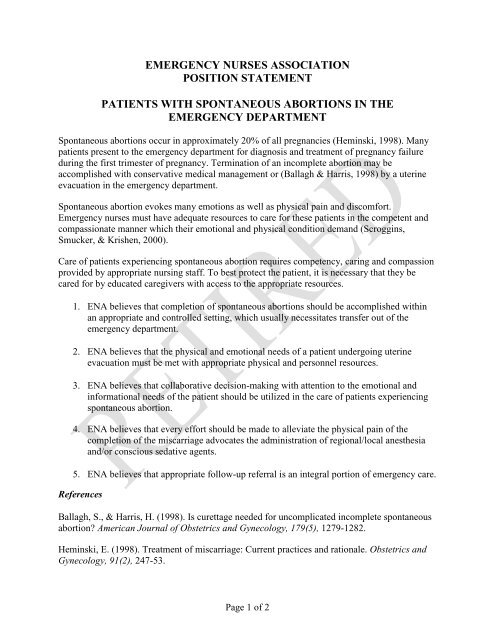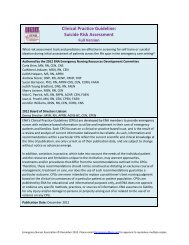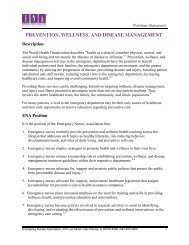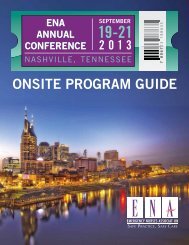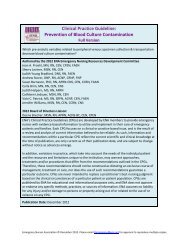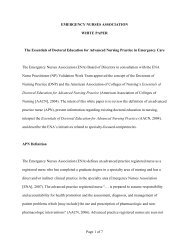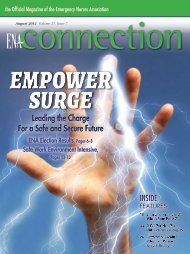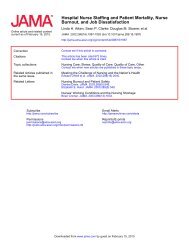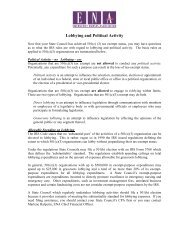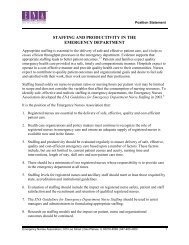Spontaneous Abortion - Emergency Nurses Association
Spontaneous Abortion - Emergency Nurses Association
Spontaneous Abortion - Emergency Nurses Association
You also want an ePaper? Increase the reach of your titles
YUMPU automatically turns print PDFs into web optimized ePapers that Google loves.
EMERGENCY NURSES ASSOCIATION<br />
POSITION STATEMENT<br />
PATIENTS WITH SPONTANEOUS ABORTIONS IN THE<br />
EMERGENCY DEPARTMENT<br />
<strong>Spontaneous</strong> abortions occur in approximately 20% of all pregnancies (Heminski, 1998). Many<br />
patients present to the emergency department for diagnosis and treatment of pregnancy failure<br />
during the first trimester of pregnancy. Termination of an incomplete abortion may be<br />
accomplished with conservative medical management or (Ballagh & Harris, 1998) by a uterine<br />
evacuation in the emergency department.<br />
<strong>Spontaneous</strong> abortion evokes many emotions as well as physical pain and discomfort.<br />
<strong>Emergency</strong> nurses must have adequate resources to care for these patients in the competent and<br />
compassionate manner which their emotional and physical condition demand (Scroggins,<br />
Smucker, & Krishen, 2000).<br />
Care of patients experiencing spontaneous abortion requires competency, caring and compassion<br />
provided by appropriate nursing staff. To best protect the patient, it is necessary that they be<br />
cared for by educated caregivers with access to the appropriate resources.<br />
1. ENA believes that completion of spontaneous abortions should be accomplished within<br />
an appropriate and controlled setting, which usually necessitates transfer out of the<br />
emergency department.<br />
2. ENA believes that the physical and emotional needs of a patient undergoing uterine<br />
evacuation must be met with appropriate physical and personnel resources.<br />
3. ENA believes that collaborative decision-making with attention to the emotional and<br />
informational needs of the patient should be utilized in the care of patients experiencing<br />
spontaneous abortion.<br />
4. ENA believes that every effort should be made to alleviate the physical pain of the<br />
completion of the miscarriage advocates the administration of regional/local anesthesia<br />
and/or conscious sedative agents.<br />
5. ENA believes that appropriate follow-up referral is an integral portion of emergency care.<br />
References<br />
Ballagh, S., & Harris, H. (1998). Is curettage needed for uncomplicated incomplete spontaneous<br />
abortion? American Journal of Obstetrics and Gynecology, 179(5), 1279-1282.<br />
Heminski, E. (1998). Treatment of miscarriage: Current practices and rationale. Obstetrics and<br />
Gynecology, 91(2), 247-53.<br />
Page 1 of 2
Scroggins, K., Smucker, W., & Krishen, A. (2000). <strong>Spontaneous</strong> pregnancy loss: Evaluation,<br />
management, and follow-up counseling. Primary Care: Clinics in Ofice Practice, 27(1), 153-67.<br />
Developed: 1993.<br />
Approved by the ENA Board of Directors: December, 1993.<br />
Revised and Approved by the ENA Board of Directors: April, 1995.<br />
Revised and Approved by the ENA Board of Directors: February, 1998.<br />
Approved by the <strong>Association</strong> of Women’s Health, Obstetric, & Neonatal <strong>Nurses</strong> (AWHONN):<br />
1998.<br />
Revised and Approved by the ENA Board of Directors: September, 2000.<br />
© <strong>Emergency</strong> <strong>Nurses</strong> <strong>Association</strong>, 2000.<br />
<strong>Emergency</strong> <strong>Nurses</strong> <strong>Association</strong><br />
915 Lee Street<br />
Des Plaines, IL 60016-6569<br />
847/460-4000<br />
Page 2 of 2


